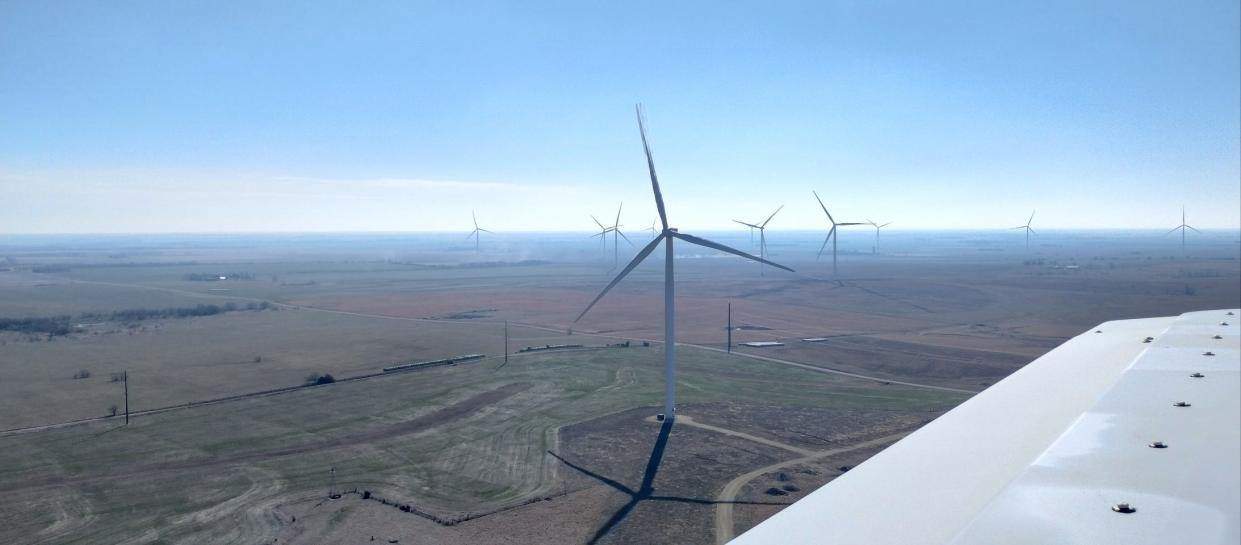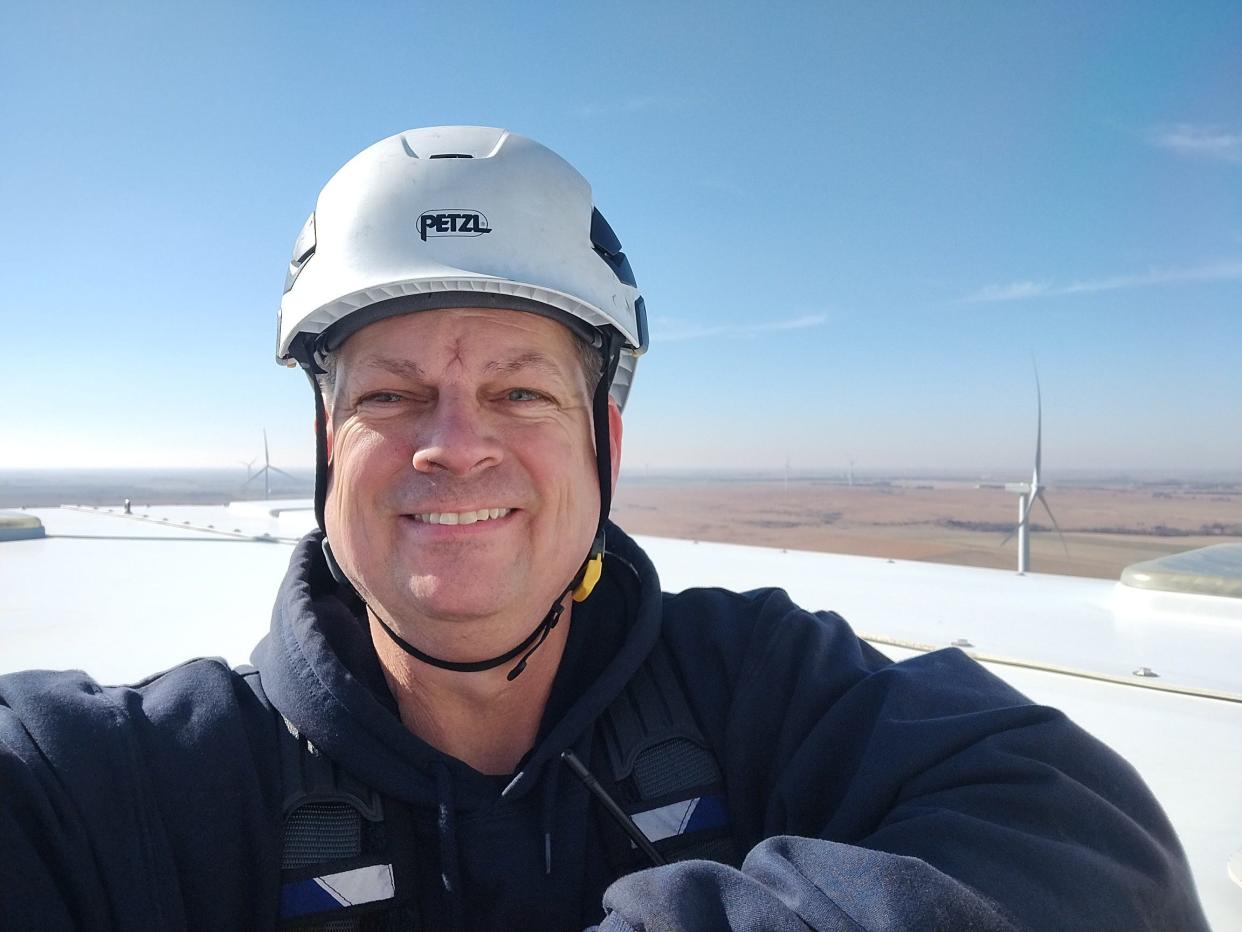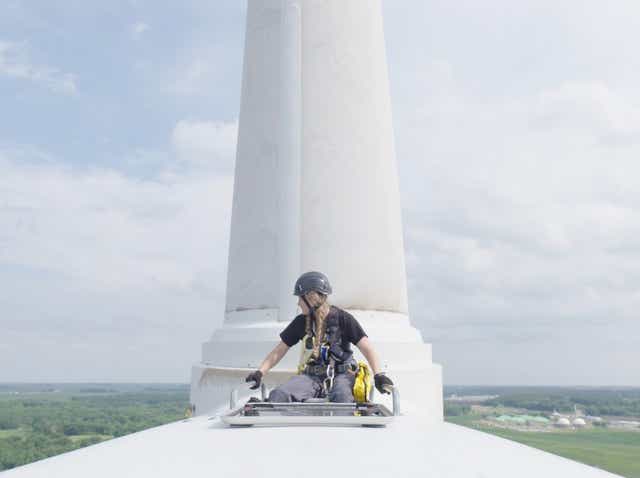Hiring boom: A two-year degree lands a green energy job that pays 'a pretty penny'
CONCORDIA, Kan. – Leah Benne a recent high school graduate, has no worries about the job market. She's in her first year of a two-year program at Cloud County Community College and when she graduates with a degree in wind technology, she expects to have her pick of jobs – most of which pay at least $40,000 a year to start.
"The training is fun, the industry is fun and it feels like you're doing something important while being paid a pretty penny," said Benne, 18.
She's one of the hundreds of students around the country enrolled in renewable energy training programs. But schools still can't keep up with the demand from employers.
For people who have worked in related fields, there are even fewer education barriers to getting a job as a wind technician.
How does climate change affect you?: Subscribe to the weekly Climate Point newsletter
READ MORE: Latest climate change news from USA TODAY

Energy companies need technicians amid green energy expansion
There's such high demand for people to work at utility-scale wind and solar farms that many companies will hire and train people with no specific experience in the field. But a two-year community college degree is a strong foundation that allows graduates to quickly work their way up to management.
"There’s more jobs right now than we can hope to have students for," said Michael Gengler, a wind professor at Iowa Lakes Community College in Estherville, Iowa. "I get one or two emails a week asking 'How many students do you have? Can we get into your class and come and talk to them?'"
What is green energy? What to know about renewable, clean power like solar and wind energy
What is carbon dioxide? Here's what to know and a look at how it contributes to global warming.
At Cloud County Community College in Concordia, renewables program director Michael "Kit" Thompson tells a similar story.
"The energy companies come to us and say 'We’ll hire 100 of your students,' and we have to tell them we’ve only go 20 right now who are looking for jobs."
Wind projects are struggling to find qualified technicians, said Neil James, vice president of Operations Maintenance and Monitoring for Apex Clean Energy. "Given the growth anticipated for the renewable energy industry, we expect these challenges to continue."
Wind technician jobs are the second fastest-growing jobs in the country, second only to nurse practitioners. The renewable power workforce employs over 443,000 Americans, said Jason Ryan with the American Clean Power Association.
According to the Bureau of Labor Statistics, the median wage for wind techs is $27.05 per hour or $56,260 a year.
"Last year, we hired over 200 wind and solar technicians, and we continue to recruit more talent this year to meet our expanding project portfolio," said Kevin Schroeder, senior vice president, Operations and Engineering for renewable company Invenergy.
What do wind technicians do?
Wind techs are people trained to work on wind turbines and wind farms. They inspect turbines, either visually or with drones, fix cracks in fiberglass turbine blades and work on the motors and electrical systems within the turbine's nacelle.
Some of the work is done at 300 feet in the air or higher. "It's very challenging," said Thompson.
Cloud graduate Barry Watkins worked as a trucker for decades, then decided to retrain for a job that seemed important. Now 48, he's loving his new career. This month his team is doing six-month service on 95 turbines. That involves changing filters, checking lubricant and hydraulic levels and topping off the grease in the blade bearings, much like a tune-up on a car – except the motors and generators are 300 feet up.
While he works in an all-male shop, he's happy to see more women coming into the field and has even encouraged his daughters to consider it.

Ashlynn Cother, a 19-year-old who will graduates from Iowa Lakes in May, says it's a great field for women.
"You have to climb, your arms and legs get a good workout. But it's not something that requires brute strength," she said.
What kind of education is required to become a wind or solar tech?
A two-year community college degree is typical. It should include training in meteorology, electrical theory, mechanical systems, applied physics, blade work, data and communications. No math is required beyond intermediate algebra but students do take classes in writing and public speaking.
"When you do a blade repair, you have to write down and document with pictures every step you take," said Thompson. "Public speaking is because our students tend to rise quickly to management positions."
These technical colleges provide students with "an excellent launching pad for a successful career in the industry," said James.
'Zombie ant fungus' in humans?: Climate change sparks fungi fears — some serious and some silly
NEWS: Will offshore wind someday power the Great Lakes states? A Lake Erie project may soon find out.
The two-year associate of applied science degree doesn't get the support it deserves, said Cother.
"There were a couple of teachers in high school who thought it could be a waste of my potential, they thought I could go to a four-year degree and then a Master's degree, but I’m happy and I love this," she said.
For people coming out of the military or who already have work experience, shorter certificate programs are available. "That's good for veterans and people who've worked in the oil industry or something like that for a few years," said Thompson.
Thereis a wide range of military experiences that are transferable to the wind industry, especially avionics, aviation and motor technicians, said a spokesperson for the international wind company Ørsted.
Many of the programs that offer wind tech degrees also offer solar programs, as much of the electronics and engineering training is the same.
"We have solar classes embedded in the program," said Gengler.
Are jobs easy to come by?
There are lots of jobs for those willing to travel or move to where a wind farm site. When Cother graduates in May, she'll move from Iowa to Watertown, South Dakota. "School ends May 12 and I start June 12," she said.
Finding a job exactly where you want to be takes more time, said Watkins. He lives in Salina, Kansas, and ended up finding a job at a wind farm in Tampa, Kansas, about a 45-minute drive from his home.

"Wind farms are typically in rural areas, they're far away from towns," he said.
How safe is the work?
Every job comes with some kind of risk and wind technicians are no exception, though there have been very few techs hurt or killed on the job in the last 15 years. Following safety precautions greatly reduces the risk, experts say. In 2021, 58 workers died in the oil and gas industries, according to the Bureau of Labor Statistics.
Working under challenging conditions 300 feet in the air is baked into the job, so safety training is paramount. All programs spend hours drilling students on using safety harnesses and safety awareness until it's second nature.
"Before you climb the towers, you go to climbing school where they put a harness on you and then put you through the wringer," said Watkins. Now that he's working in the field he doesn't really think about it much. "After you've done it a few times, you just really focus on your job, you don't think about the height that much."
Though he does take a peak out the nacelle now and again. "I take a moment to look around at how beautiful it is."
How much does it pay?
Anyone who graduates from a two-year program can easily start out at $24 to $25 an hour and up.
"Most of my students start at over $40,000 if they get a job working at a wind farm. If they’re traveling they usually start at $60,000," said Thompson. "But the great thing is how quickly the raises happen. By their third or fourth year, their income is up to $60,000 and for the ones that are traveling it’s $80,000."
Is fear of heights a problem?
Modern wind turbines are typically at least 300 feet tall and future installations are expected to be even higher, so there's no getting around that this is work that requires climbing.
That said, being uncomfortable with heights isn't a problem – you just can't be paralyzed with fear, said Thompson.
The safety training and intensive training in proper protocols and use of equipment goes a long way toward quieting fears, he said. For those for whom heights turn out to be a deal-breaker, "maybe you should go into the solar side of things," he said.
What's the best part of the job?
"There's just so much variety," said Faith Lutat, 22. She's three years into her career after graduating from Iowa Lakes. "I don't feel like I'll ever slow down or get bored, there's always something new to do."
On top of that, as an outdoor person, the view "literally cannot get old," she said. "If the fog's rolling in or there's snow or whatever, it's always amazing."
This article originally appeared on USA TODAY: Green energy jobs: Wind tech hiring boom doesn't require 4-year degree
